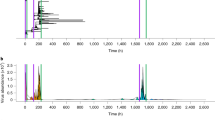Abstract
Cytotoxic T lymphocytes (CTLs) play an important role in the immune response to HIV during the acute stage of infection, but the effect of CTLs on HIV intrahost genetic diversity is poorly understood. We introduce a model of CTL attack during the acute stage. Assuming this model, we develop a method to sample HIV intrahost genealogies. Using our sampling approach, we characterize the evolutionary forces that shape HIV genealogies. In particular, we show that early mutation events can have significant impact on HIV genealogies and that certain types of CTL attack are best at controlling HIV genetic diversity. Our sampler represents a first step toward using HIV genetic data to infer properties of CTL attack.
Similar content being viewed by others
References
Achaz, G., et al. (2004). A robust measure of hiv-1 population turnover within chronically infected individuals. Mol. Biol. Evol., 21(10), 1902–1912.
Antia, R., et al. (2003). Models of cd8 responses: 1. what is the antigen-independent proliferation program. Nat. Rev., 221, 585–598.
Athreya, K. B., & Ney, P. E. (1972). Branching processes. Berlin: Springer.
Barton, N. H., et al. (2004). Coalescence in a random environment. Ann. Appl. Probab., 14, 754–785.
Borrow, P. H., et al. (1994). Virus-specific cd8+ cytotoxic t-lymphocyte activity associated with control of viremia in primary human immunodeficiency virus type 1 infection. J. Virol., 68, 6103–6110.
Carrington, M., & O’Brien, S. J. (2003). The influence of hla genotype on aids. AIDS Annu. Rev. Med., 54, 535–551.
Drummond, A. J., & Rambaut, A. (2007). Beast: Bayesian evolutionary analysis by sampling trees. BMC Evol. Biol., 7, 214.
Durrett, R. (2002). Probability models for DNA sequence evolution. Berlin: Springer.
Durrett, R., & Schweinsberg, J. (2004). Approximating selective sweeps. Theor. Popul. Biol., 66, 129–138.
Goonetilleke, N., et al. (2009). The first t cell response to transmitted/founder virus contributes to the control of acute viremia in hiv-1 infection. J. Exp. Med., 206(6), 1253–1272.
Hermisson, J., & Pennings, P. S. (2005). Soft sweeps: molecular population genetics of adaptation from standing genetic variation. Genetics, 169, 2335–2352.
Kaplan, N. L., et al. (1988). The coalescent process in models with selection. Genetics, 120, 819–829.
Kaplan, N. L., et al. (1989). The hitchhiking effect revisited. Genetics, 123, 887–899.
Keele, B. F., et al. (2008). Identification and characterization of transmitted and early founder virus envelopes in primary hiv-1 infection. PNAS, 105(21), 7552–7557.
Kelleher, A. D., et al. (2001). Clustered mutations in hiv-1 gag are consistently required for escape from hla-b27-restricted cytotoxic t lymphocyte responses. J. Exp. Med., 193, 375–386.
Kepler, T. B., & Oprea, M. (2001). Improved inference of mutation rates: I. an integral representation for the Luria-Delbruck distribution. Theor. Popul. Biol., 59, 41–48.
Kingman, J. F. C. (1982). The coalescent. Stoch. Process. Appl., 13, 235–248.
Koup, R. A., et al. (1994). Temporal association of cellular immune responses with the initial control of viremia in primary human immunodeficiency virus type 1 syndrome. J. Virol., 68, 4650–4655.
Kuhner, M. K. (2006). Lamarc 2.0: maximum likelihood and Bayesian estimation of population parameters. Bioinformatics, 22(6), 768–770.
Leigh-Brown, A. J. (1997). Analysis of hiv-1 env gene sequences reveals evidence for a low effective number in the viral population. PNAS, 94, 1862–1865.
Lemey, P., et al. (2007). Synonymous substitution rates predict hivdisease progression as a result of underlying replication dynamics. PLoS Comput. Biol., 3, 282–292.
Lemey, P., Salemi, M., & Vandamme, A.-M. (2009). The phylogenetic handbook: a practical approach to phylogenetic analysis and hypothesis testing (2nd ed.). Cambridge: Cambridge University Press.
Mansky, L. M., & Temin, H. M. (1995). Lower in vivo mutation rate of human immunodeficiency virus type 1 than that predicted from the fidelity of purified reverse transcriptase. J. Virol., 69, 5087–5094.
Markowitz, M., et al. (2003). A novel antiviral intervention results in more accurate assessment of human immunodeficiency virus type 1 replication dynamics and t-cell decay in vivo. J. Virol., 77, 5037–5038.
Merrill, S. J. (2005). The stochastic dance of early hiv infection. J. Comput. Appl. Math., 184, 242–257.
Mohle, M. (2005). Convergence results for compound Poisson distributions and applications to the standard Luria-Delbruck distribution. J. Appl. Probab., 42(3), 620–631.
Nolan, J. P. (2011). Stable distributions—models for heavy tailed data. Boston: Birkhauser. In progress, Chapter 1 online at academic2.american.edu/~jpnolan.
Nowak, M. A. (2006). Evolutionary dynamics: exploring the equations of life. Harvard: Harvard University Press.
Nowak, M. A., & May, R. M. (2000). Virus dynamics: mathematical principles of immunology and virology. London: Oxford University Press.
Perelson, A. S. (1996). Hiv-1 dynamics in vivo: virion clearance rate, infected cell life-span, and viral generation time. Science, 271, 1582–1586.
Perelson, A. S. (2002). Modeling viral and immune system dynamics. Nat. Rev., 2, 28–36.
Rouzine, I. M., et al. (2001). Transition between stochastic evolution and deterministic evolution in the presence of selection: general theory and application to virology. Microbiol. Mol. Biol. Rev., 65(1), 151–185.
Schmitz, J. E., et al. (1999). Control of viremia in simian immunodeficiency virus infection by cd8+ lymphocytes. Science, 283, 857.
Slatkin, M., & Hudson, R. R. (1991). Pairwise comparisons of mitochondrial DNA sequences in stable and exponentially growing populations. Genetics, 129, 555–562.
Stafford, M. A., et al. (2000). Modeling plasma virus concentration during primary HIV infection. J. Theor. Biol., 203, 285–301.
Weir, B. S. (1996). Genetic data analysis II. Sunderland: Sinauer.
Wick, D., & Self, S. G. (2000). Early HIV infection in vivo: branching process model for studying time of immune responses and drug therapy. Math. Biosci., 165, 115–134.
Zheng, Q. (1999). Progress of a half century in the study of the Luria-Delbruck distribution. Math. Biosci., 162, 1–32.
Zheng, Q. (2008). On Bartlett’s formulation of the Luria-Delbruck mutation model. Math. Biosci., 215, 48–54.
Author information
Authors and Affiliations
Corresponding author
Rights and permissions
About this article
Cite this article
Leviyang, S. Sampling HIV Intrahost Genealogies Based on a Model of Acute Stage CTL Response. Bull Math Biol 74, 509–535 (2012). https://doi.org/10.1007/s11538-011-9670-4
Received:
Accepted:
Published:
Issue Date:
DOI: https://doi.org/10.1007/s11538-011-9670-4




